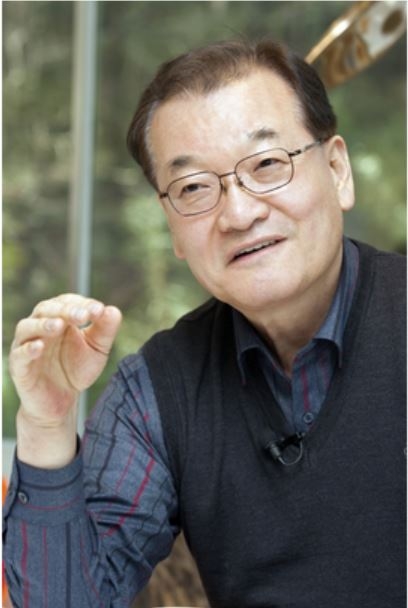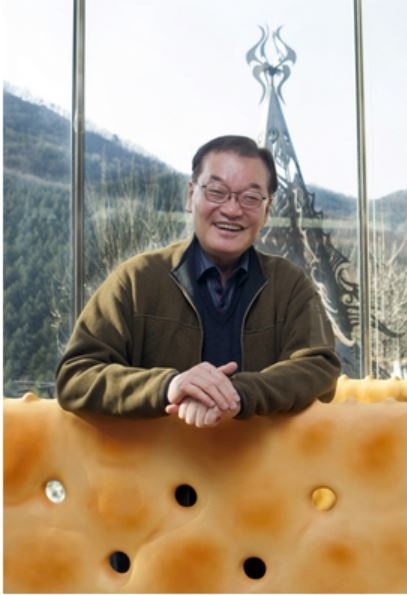[Video clip] Interview with Crown-Haitai Confectionery CEO Yoon Youngdal
On a clear, sunny day, the Women’s News went to Songchu to meet Crown-Haitai Confectionery CEO Yoon Youngdal who has had successfully realized his dreams.
CEO Yoon is the pioneer of Korea’s ‘Art and Business management’ which is a style of management that incorporates art into a business. Since 2004, he has created a new wind of ‘art’ and conducted ‘art’ experiments in the confectionery market. Some of them are ‘Chang-sin-je,’ a performance of fusion Gukak (Korean traditional music), and ‘Box Art,’ a plastic art product made out of snack boxes and packaging. Preceded by the founder Yoon Taihyun who died in 1999, Yoon Youngdal succeeded his family business in 1995. After making an early recovery from the Asian Financial Crisis, Yoon successfully acquired his arch-rival, Haitai Confectionery & Foods, in 2005. As of 2012, Crown-Haitai posted a sales record of KRW 1137.9 billion, reaffirming its position as No. 1 in the industry. Yoon has begun building on the success by harnessing the power of ‘Artistic Quotient (AQ)’ to enhance communication with customers.

- You are famous for introducing art to the field of business management.
“At a time when my confectionery business began sliding, my employees and I arduously searched for a solution to make a breakthrough. That is when we thought of art as the key to sustain our business. Based on the analysis that mothers, these days, do not consider confectionery as a healthy snack for their children, we thought that we needed a mediator so that we can better communicate with our customers and gain their trust. Our answer was ‘Artistic Quotient (AQ),’ a type of intelligence that encourages people to feel a sense of creation in their daily life and to meet their inner desire to create something out of anything they can put their hands on, just as artists do. AQ is starkly different from an ability of copying or repeating what has already been done and understanding or practicing what has already been known. It is about producing a new creation by using any material or tool, thereby allowing one to satisfy his or her thirst for aesthetics, transcendence, immersion, communication, and amusement. Through offering new values embedded in our products, we have been trying to stoke people’s passion toward the act of creation and to draw their participation in activities or programs that we offer. Our strategy is in line with Disneyland’s ‘immersion,’ Google’s ‘amusement,’ Holly Davidson’s ‘transcendence,’ and Lego’s ‘communication.’
- Why do we need art in management?
The 20th century was the era of ‘Intelligent Quotient,’ or IQ. IQ tests were designed to assess whether people are equipped with the right kind of intelligence in a society that prioritizes technology. The essence of technology is to follow patterns, discover rules, and implement such rules, while minimizing cost and error. However, as we all know, IQ shows only a fraction of what we can do. It does not indicate a person’s ability to communicate or sympathize with others or its impact on a society or an organization.
Then followed ‘Emotional Quotient’ introduced by Daniel Goleman, a renowned psychologist for his achievements in neuroscience. According to him, EQ explores new areas of sensibility, feeling, and emotion. In other words, it is a measurement of a person’s ability to recognize or control his or her emotions, and to understand and care for others.
Since then many other models emerged including ‘Society Index,’ ‘Multi-index Model,’ ‘Creativity Index,’ and ‘Visual Index.’ Against this backdrop, we strongly felt the need to come up with a new indicator that covers nearly every aspect of different indices. That is how AQ was born.
To address such changes of the times, we concluded that art is a prerequisite for a success in management."
- How do we improve AQ?
“These days, workers are required to have artistic skills as pure and creative as those of children. Unlike technologies, techniques, strategies, and capital, creative or artistic ideas and emotions have become rare and essential resources. I need to remind you that AQ does not grade people based on objective standards.
The ultimate goal is to enable people to realize how artistic they are and to help them upgrade their life as much as possible. AQ is not a mere test or an area that needs to be studied. AQ will be enhanced when people are given more opportunities to appreciate music, throw themselves into the realm of art, and make sculptures on their own. They need firsthand experiences and observe their feelings. The higher the AQ, the greater the possibility for Korea’s per capita GDP to exceed the threshold of $40,000 or even $50,000. I want to emphasize the role of AQ in enabling Korea to join the ranks of advanced countries.”
- Songchu Art Valley seems like a base camp for ‘AQ management.’
“Songchu Art Valley was constructed on a site that my father bought long time ago. It is about 3.3 million ㎡ in size and located near Songchu Amusement Park. Although my father had a golf course in mind, I decided to turn the area into a complex that is home to a training institute, art studios, a school that teaches Gukak or the Korean traditional music, coffee shops, and art valleys. There are special trails that visitors can enjoy.
Songchu was a famous hang-out for families until the mid-1990s when love hotels flooded the area. We bought and converted them into workshops where new or leading sculptors would reside and produce creative work. Despite the initial plan to support both painters and sculptors, we ended up sponsoring sculptors only because their financial difficulties were particularly burdensome. Throughout the Art Valley, you would notice some pieces sculpted by our exmployees and sculptors we sponsor. Not just that, we offer a class so that our customers can learn Gukak.“

- Why do you put more focus on Gukak?
“Since the foundation of RAGEUM Orchestra, we hosted a series of Gukak festivals such as ‘Chang-sin-je,’ ‘Festival of the Masters in celebration of Daeboreum,’ and ‘2013 Seoul Arirang Festival.’
We realized that we could not excel in everything. Based on our experiences of holding different types of music concerts and opera festivals, we decided to concentrate on Gukak.
We have our own way of maintaining a balanced approach. For instance, we are thinking of bringing musical and Gukak together. As for other areas like art and literature, we have set out mind on sponsoring sculptors and poets, respectively.
By nature, every human has an artistic instinct. The main objective for confectioners, therefore, is to satisfy such instinct with confectioneries. To that end, we, producers, have to develop our own artistic strength and acquire experiences.”
- Among diverse performances played during ‘Chang-sin-je’ last year, Ttechang or ‘singing in group’ was particularly awesome.
“Every autumn, we host ‘Chang-sin-je’ at Sejong Center. ‘Chang-sin’ means transforming old things to make new use of them. It has been almost a decade since we launched the festival.
With 100 executives and employees participating in the performance, Ttechang was registered in the Guinness Book of World Records, last year, for the greatest number of people singing together Pansori, a Korean traditional narrative song.
Western ensembles stress a chord. In contrast, 100 people need to sing in one voice in Ttechang. ‘100’ is more than just a number. In the traditional culture of Korea, it means perfectness. This coincides with Crown-Haitai’s vision to pursue perfection through a harmony of a group of people, let’s say 100 people.
Frankly speaking, the initial goal of ‘Chang-sin-je’ was to help employees develop artistic sensibility. Now, it has become the biggest fusion Gukak performance in Korea. With a steady increase of outside visitors, what began as an in-house event has expanded in size.
‘Festival of the Masters in celebration of Daeboreum’ and ‘Go-guk-hyang (a Korean abbreviation for ’The scent of Gukak to customers’) are thank-you parties for our customers. They check the date and anxiously wait for these parties.
- Employees might be burdened by having to learn how to sculpt or sing Gukak.
“Coercion does not work. To keep doing something, you have to like it. This simple principle holds true for art as well. Those who knew nothing about Pansori have fallen in love with it. Still, Pansori may not appeal to some people. There may be others who are practicing it reluctantly or those who already gave up because they disliked it so much.
What matters, however, is to give a chance to develop one’s capacity. As long as there is an opportunity, anybody can see for oneself that his or her artistic competence can be cultivated.
I, myself, knew nothing about Gukak. Now I enjoy it very much. The more I practice, the happier I get. Isn’t it superb to be able to work at a company that runs a class for something you can utilize for more than half a century? The more time you spend on doing something, the more you will like it. And once you like it, you will find yourself immersed in it. This is why I always tell my workers to come and talk to me only when they think they tried enough.“
- Beside from manager, what did you want to be in the future?
“Since my childhood years, I have always had a profound interest in machines. In my 30s, I set up an independent automobile parts maker. I even translated a book on wind power generation.
Though currently under experiment in the lab, we are planning to build a windmill to supply energy needed to operate Songchu Art Valley. If we tap into wind, water, and geothermal energy, Art Valley will be energy self-sufficient."
- If you were to share with mothers out there some of your educational philosophical approaches you acquired from your experiences in ‘Art and Business management,’ what would they be?
“Immersion is the key. Children need to learn to concentrate on studying and to spend their free time on doing something they love. Forcing children to study does not help them develop their interpersonal skills and other capabilities.
The level of concentration normally gets higher in a limited period of time. This applies to workers as well as students. Work efficiency improves when employees are immersed in their work.
If you look at cases like figure skater Kim Yuna and speed skater Lee Sanghwa, you would notice it right away that you need to concentrate on one thing to succeed.“
- What does the future hold for Crown-Haitai?
“We want to gain full recognition from our customers. I would appreciate it very much if people welcome our decision to raise prices, saying ‘Crown-Haitai products deserve a higher price.’ (laughter)
We want to impress them. We aim to grow bigger and boast world-class quality in the industry. We want to make products that people desire not only to relieve their hunger, but also to feel happy.
We built Art Valley in the same context. We want our visitors to refresh themselves with artistic intelligence and emotions, and go home recharged with a sense of creation.“
CEO Yoon Youngdal graduated from Yonsei University with a BA in physics. He also went to Korea University for his MA in the Graduate School of Business Management. In 1995, he took office as CEO of Crown Confectionery Co., Ltd. He became CEO of Crown-Haitai Confectionery Co., Ltd. in 2005. As chairman of Seoul Open Art Fair, Art Gwangju, International Sculpture Festa, and Seoul Arirang Festival, he actively sponsored artists. He was granted an award from the Korean Academy of Business Historians, CEO Grand Prize from Korean Marketing Association, and Montblanc de la Culture Arts Patronage Award. One of books he published is ‘Cross-marketing Business Strategy, AQ.’

